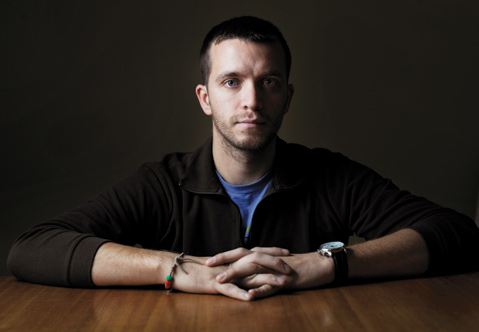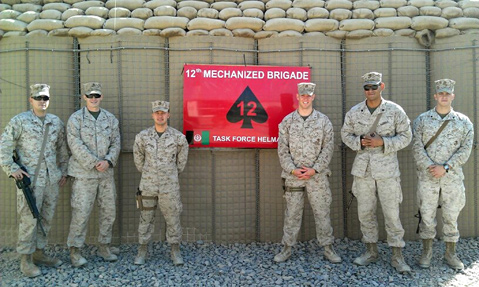Hidden Wounds: Vets Desperate for Mental Health Care
As Santa Barbara's VA Flails, Many Suffer Alone

Every soldier has a wartime memory that aches deeper than the others. For Corporal Michael Stout, it was the first few minutes of a predawn raid that went terribly wrong.
Stout was a Marine Corps air support operator on his second deployment in 2013, directing coalition attacks and medevacs in Afghanistan’s battle-scarred Helmand Province. One morning just before 4 a.m., he safely guided a Danish Special Forces helicopter to its landing site at a nearby village. As the chopper touched down and the troops jumped out, one of them immediately stepped on an IED that tore off his left arm and leg. “It happened just like that,” said Stout with a snap of his fingers. “The situation shifts so quickly.”
The Special Forces team repeatedly radioed for a rescue, and a U.S Marine helicopter still circling the area confirmed over and over it was ready to swoop in. But the mission’s commander, “looking out for the lives of the marines on that aircraft — the multimillion-dollar aircraft — and the mission,” denied the requests, which Stout had to relay to the desperate men in the field. “The commander just kept saying, ‘No, no, no,’” remembered Stout, his eyes brimming. “It was just the saddest moment …” When marines transport a soldier killed in action, they announce they’re carrying an “angel.” That morning, Stout helped lead one angel back to base.
The memory still haunts him. So do many more moments of sudden death and violence. Stout coordinated daily gun runs and Hellfire strikes against the Taliban. “When there was downtime, I started to realize I played a significant part in killing people I didn’t know,” said Stout. It wasn’t enough that American generals and politicians said he was fighting in a justifiable war. “With what I felt, it was hard to reconcile,” he said.
Stout, 24, left the Marine Corps in May 2013 and enrolled in Santa Barbara City College. He jumped straight into his studies, met a girl, worked security at Dargan’s, and began a newswriting and photography internship with this paper, where I was his supervisor. In person, Stout was gracious and plainspoken with a wry sense of humor. He excelled as an intern. Something, however, was weighing heavily on his mind.
It was only later that I learned Stout was struggling with PTSD, post traumatic stress disorder. “I had a lot I wasn’t dealing with at the time,” he said. “I didn’t even have the words to ask myself the deep moral questions I had about my experience in Afghanistan.” Stout noticed he was becoming perpetually anxious. He began to worry about how much he was drinking, which, as the son of two addicts, was always a concern of his. He had nightmares of being shot at in a guard tower. His relationships suffered. He’d jump to full alert when a helicopter passed overhead. Hoping to numb this inner pain, he kept as busy and distracted as possible.
Then Stout read a description of PTSD and thought to himself, “Man, this is me.” This is when he reached out for help. It turned out to be relatively simple to schedule an appointment at the Veterans Affairs outpatient clinic on Calle Real, where a psychiatrist diagnosed him with the disorder. He was prescribed an antidepressant, but the medication left him groggy and uncomfortable. What he really wanted to do was talk to someone.
Booking the regular therapy sessions his VA benefits entitle him to, however, has proved exceptionally difficult — he’s had only two appointments since his screening three months ago. “I asked to be seen more often, but they said they didn’t have the staff,” he said. “I’d really like to see someone at least every other week.”
Stout echoes a complaint being voiced by an increasing number of Santa Barbara veterans troubled by extremely long wait times and frustrated with the VA’s often impenetrable bureaucracy. It’s a nationwide problem, especially as more public attention is paid to PTSD and suicide rates among soldiers. Santa Barbara’s vets stress clinic doctors and nurses are excellent and doing their best, but they don’t have the staffing or hours to help.
Grievances started climbing this summer after the Calle Real clinic lost some of its staff to attrition, lured away by less exhausting jobs with better pay. Because of the VA’s lengthy hiring process, it can take five or more months to find replacements. “Our office has had a noticeable uptick in complaints about VA care,” said C.J. Young, press secretary for Representative Lois Capps. “People are upset that their calls aren’t being answered and that their cases are being kicked down to Los Angeles.”
Dr. Joe Blum worked as a physician in the Santa Barbara outpatient clinic for more than three decades before retiring five months ago. He described the same problems — overtaxed caregivers hamstrung by a rigid system of checks and balances that drowns them in paperwork and keeps them from patients. “They’re very dedicated and feel honored to work for our veterans, to go beyond duty on all levels,” he said. “But for some reason, because of these administrative hurdles, they’re unable to take care of people in a timely fashion.”
In April 2014, a damning spotlight was thrown on the VA when CNN reported at least 40 veterans died while waiting for care at the Veterans Health Administration facilities in Phoenix. An investigation revealed that clinic records had been manipulated to meet performance goals, which kept more than 1,700 veterans off an official waiting list. Federal officials concluded the VA had displayed “significant and chronic system failures” within a “corrosive culture” of administrative misconduct. In the wake of the scandal, Secretary of Veterans Affairs Eric Shinseki resigned, and Congress passed a $15 billion bill to drastically overhaul the agency by increasing staff levels and improving access to non-VA medical centers.
But the department still struggles to manage patients’ schedules, according to a report issued Wednesday by the U.S. Government Accountability Office. A review of 100 cases nationwide found vets waited an average of 26 days from their first request for mental-health treatment to get an appointment. Some waited up to 279 days. Others were forced to go 57 days after their first assessment to begin treatment.
VA officials said they’re taking the report seriously. The department admitted individual clinics are having a hard time meeting demands but noted hiring goals have been reached at the national level. The VA hired 5,300 mental-health clinicians and administrative staff from 2012-2013, and increased mental-health staffing by a fourth between 2010 and 2014. Still, a federal audit released this August says the VA hasn’t been effective in its hiring opportunities or using existing personnel to improve access to timely care. The agency doesn’t have a good way of determining staffing needs at specific locations, and so 94 of 140 facilities are still short of psychiatrists. The deficit is exacerbated by a countrywide scarcity of psychiatrists in general.
Santa Barbara’s VA clinics — the Calle Real location and an office in Santa Maria — provide health care to 5,437 individual veterans. It has offered mental-health services to 2,487 vets so far this year, compared to 2,147 in 2010. Practitioners have held 12,252 appointments in 10 months this year, up from 9,969 in all of 2010. Those sessions include face-to-face encounters or meetings set up through what the VA calls “telemedicine technology.”
The mental-health team in South County currently consists of one part-time psychologist and two part-time psychiatrists. Three existing positions remain open and unfilled — for a psychiatrist, psychologist, and nurse. A new psychiatrist position will be created next year.
The North County clinic at the moment has three psychologists (who split their time with the San Luis Obispo office), one psychiatrist, three social workers, and a nurse practitioner. It is looking to hire two psychologists, two social workers, and an additional nurse.

VA spokesperson Michiko Riley in Los Angeles was unable to provide answers to some of the other questions submitted by The Santa Barbara Independent last Friday, such as how long the average wait time is for veterans seeking an initial mental-health diagnosis, what other agencies or organizations the VA refers patients to if it can’t provide the needed care, or exactly how often a VA patient is able to meet with a mental-health worker. Riley said the paper’s Tuesday-afternoon deadline was too quick of a turnaround for the media-submission process at her office, which has a new boss. “With new leadership comes new policies,” she said. “A year ago, it might not have been a problem.”
The Veterans Center in Ventura often fills the void left by the clinics. Though technically under the VA umbrella, it operates independently as a more nimble, community-based haven for 4,500 Ventura and southern Santa Barbara county vets. Its five full-time counselors, four of whom are veterans, provide one-on-one and group therapy, connecting with patients through UCSB, SBCC, the Veterans Memorial Building, and via events like air shows, Stand Down, and VetNet meetings.
Vet Center outreach specialist Jose Perez said the criticism he hears most often from those seeking help from the clinics is that the locations are shorthanded and can’t hold onto their employees. “As soon as they get to know a doctor, the doctor moves on,” said Perez. “That’s a concern.” Perez estimated that 65-75 percent of the vets his office serves suffer from PTSD.
More and more, Central Coast communities are picking up the slack, as well, Perez said. “Santa Barbara has been amazing the last two years,” and San Luis Obispo, which has its own Vet Center, is “becoming a model for veteran care.” Perez said that running the VA gauntlet can be a daunting task but the resources are out there. “I personally feel loved and supported by the VA,” he said. “I would encourage all veterans to not give up. Even if you get a few ‘Nos,’ keep looking.”
Dr. Larry Decker agreed the Central Coast safety net is a strong one. “I think there are quite a few options here,” he said, pointing to the new Veterans Choice Program that allows patients to see a private practitioner if VA wait times are too long, no specialists are available, or if the closest clinic is located especially far from a vet’s home.
Hazel Blankenship with the Pierre-Claeyssens Foundation said the same thing. “It’s better than it was. There’s a lot more available compared to just a few years ago.” The New Beginnings Counseling Center, Vista Del Mar, Jewish Family Services, Oxnard Family Circle, Catholic Charities, Casa Esperanza, UCSB’s Veterans Resource Team, and the Veterans Treatment Court have all been routinely praised for their good work.
Decker cofounded the Ventura Vet center (which was originally located in Santa Barbara until it moved south to be closer to a bigger vet population), and he now contracts with it through his Garden Street practice. He specializes in PTSD and wrote a book on the condition. “If you’re in combat and trying to kill people, and people are trying to kill you, that changes who you are,” he said. “Combat soldiers really know something that we civilians don’t know. And for the most part, civilians don’t care. Vets recognize that easily.”
That inability to relate, which Stout described in detail upon his return home, isolates, saddens, and angers many veterans, Decker said. “People go to movies and read books, and they think they know what these guys go through,” he went on. “That’s total crap.” Studying PTSD, as he put it, is a moral opportunity for the rest of the U.S. population to become more sensitive to what men and women endure on the battlefield and what they deal with stateside. Decker and others remembered the case of Eddie Van Tassel, an Iraq war veteran with PTSD who waved an American flag and brandished an unloaded pistol on the La Cumbre overpass in 2008 to bring attention to veterans’ issues.
The Wounded Warrior Project publicized a survey this week of 23,000 injured soldiers who fought in Afghanistan and Iraq. More than three quarters of them — 76.2 percent — said they are struggling with PTSD, and 35 percent said they’ve experienced difficulty getting mental-health care. Defense Department estimates put the number of veterans with obvious physical injuries from the wars at around 52,000 but more than 10 times that figure as suffering from post-traumatic stress disorder and traumatic brain injury.
New government research shows that between 2000 and 2010, 43,208 veterans committed suicide. Among men 18-29 years old, the annual number of suicides per 100,000 people was 83.3 for veterans and 17.6 for nonveterans. A total of 6,840 U.S. service members have been killed in the Iraq and Afghanistan wars.
Stout said sharing his inner demons has helped soften the effects of PTSD. He’s stopped drinking, as well, and he recently turned a corner where the future doesn’t seem so dim. “I’m really glad I feel that way,” he said with obvious relief. His advice for other veterans is to let it out. “Talk to another vet,” he said. “Try to connect. Talk about anything and everything so you can start putting words to your thoughts.”
So he can help fellow soldiers help themselves should they need support, Stout wants to become a social worker. “The system is structured well, but it often doesn’t work the way it’s supposed to,” said Stout, who even after volunteering at a veteran resource center has had a hard time navigating his health-care options. His roommate, also a veteran, just received a $600 bill from Cottage Hospital for services he was incorrectly told were covered by his VA benefits.
Stout understands changes at the VA need to happen on a national level for there to be any big impacts here in Santa Barbara. In the meantime, he declared, “They need to put a lot more effort into the front end and have as many people as they need to see vets adequately.” It can be hard for marines like him to ask for a hand, so when they do, it should be there, Stout said. “We’re not broken, but we are different.”
4• 1• 1
The Department of Veterans Affairs maintains a hotline for veterans in crisis that operates 24 hours a day. Call 1 (800) 273-8255, go to veteranscrisisline.net/chat, or send a text to 838255.



